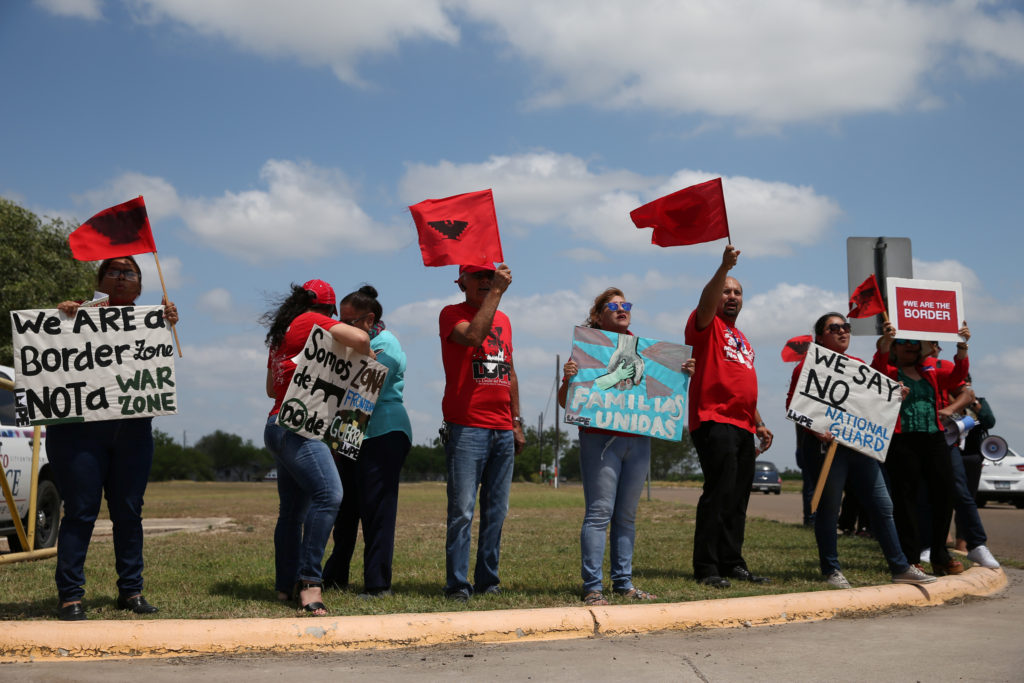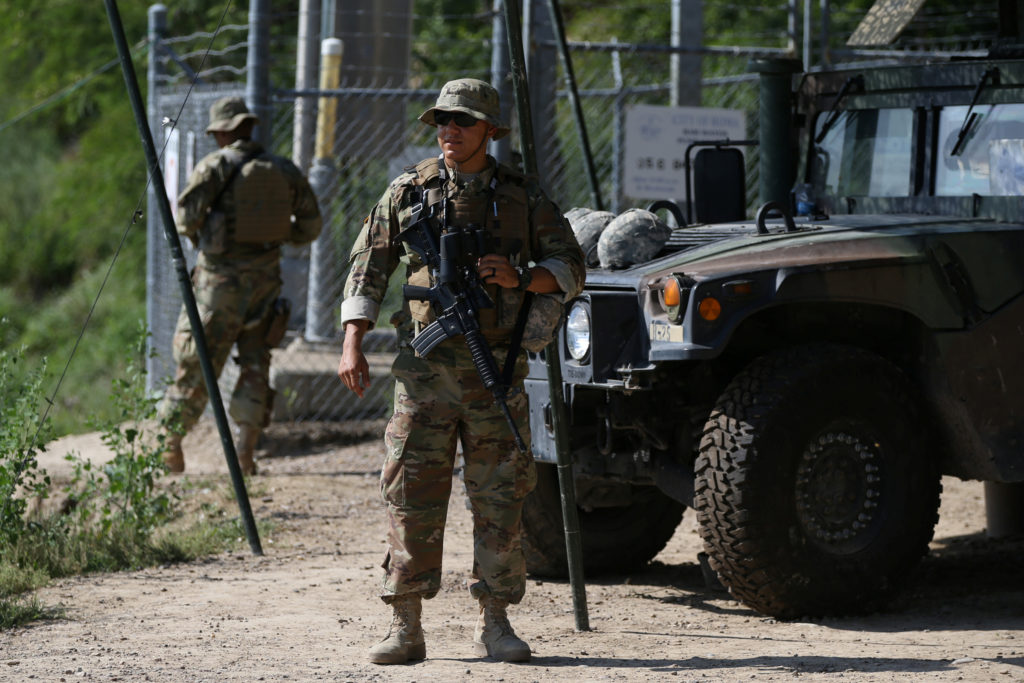By Carol Zimmermann
Catholic News Service
WASHINGTON (CNS) — Catholic Church leaders and immigration advocates say President Donald Trump’s recent moves to clamp down on immigration are extreme and unnecessary.
The president’s latest efforts to curb U.S. border crossings call for National Guard troops to be deployed along the border and ending the so-called “catch and release” practice of allowing immigrants seeking asylum in the U.S. to be released from detention while awaiting a court hearing.
The April 4 announcement about deploying 4,000 troops to the U.S.-Mexico border was followed two days later with the announcement that the president was discontinuing the “catch and release” practice, a phrase which itself is problematic, according to immigration advocates.
The call for troops at the border, a move also made by Presidents George W. Bush and Barack Obama, has received the most attention. Arizona Gov. Doug Ducey, along with other Republican governors of Texas and New Mexico — all states that border Mexico — have supported it and have already begun sending troops to the region.
Ducey sent 325 National Guard members to the border by the second week of April. Texas Gov. Greg Abbott sent 250 and said 750 more would join in coming weeks. New Mexico has sent 80 troops to date and plans to send 250.
California Gov. Jerry Brown, a Democrat, did not immediately commit to sending troops but announced April 11 that the state would send 400 National Guard members to the border, stipulating that they would fight crime, not enforce White House policies.
“This will not be a mission to build a new wall. It will not be a mission to round up women and children or detain people escaping violence and seeking a better life,” Brown said in a letter to the secretaries of defense and homeland security. “The California National Guard will not be enforcing federal immigration laws.”
Defense Secretary Jim Mattis said the troops will follow a “no contact with migrants” policy and will provide air support, maintain roads and operate surveillance systems, among other duties.

Brown also said he sided “with the Catholic bishops who have said that local, state and federal officials should ‘work collaboratively and prudently in the implementation of this deployment, ensuring that the presence of the National Guard is measured and not disruptive to community life.’” The governor was referring to a statement issued April 6 by eight Catholic bishops from U.S.-Mexico border states criticizing troop placement at the border.
In the statement, the bishops said the border region was not a war zone and seeking refuge from persecution and violence is not a crime.
The California governor was not alone in publicly agreeing with the border bishops. The Mexican bishops’ conference quoted the U.S. bishops’ statement in an April 7 letter to people in Mexico and the United States and the presidents of both countries opposing the troops at the border and Bishop Joe S. Vásquez of Austin, Texas, chairman of the U.S. Conference of Catholic Bishops’ Committee on Migration, also sided with the border bishops in an April 11 statement emphasizing: “Our faith calls us to respond with compassion to those who suffer and seek safe haven; we ask our government to do the same.”
But despite such criticism, National Guard members began arriving at the border just days after the plan was announced.
Joanna Williams, director of education and advocacy for the Kino Border Initiative based in Nogales, said April 10 that she hadn’t seen extra troops, but that didn’t mean people weren’t talking about them.
The Kino Border Initiative is a migrant ministry sponsored by Jesuits, Missionary Sisters of the Eucharist and the dioceses of Tucson, and Nogales, Mexico. It works on both sides of the border, ministering to those who have been deported and doing advocacy work.
Williams said not many migrants seemed too aware of the upcoming increased military presence. Instead, she has seen more anxiety from residents in the border area who already feel “heavily surveilled.”
“It’s too early to see implications of this,” she said, adding that for now, the idea of more troops in the area seemed more “symbolic in a dangerous way.” She also said it was hurtful and contradictory to the day-to-day reality she sees of people coming back and forth across the border, something she does daily.

Williams also didn’t see how the increased military presence would make a difference for those wishing to cross the border and added that it didn’t address why so many people are coming to the U.S.
“Their reasons for migrating are so powerful, that it’s not a matter of how much border security you can put in” to stop it, she said.
She said it would be more beneficial to have social workers or medical staff on hand to free Border Patrol agents to do more work in the field. Such proposals have been introduced in bills in Congress but never made it out of committees.
Results of a poll of registered voters released April 11 showed that 48 percent of respondents said they strongly supported or somewhat supported Trump in sending troops to the border; 42 percent opposed the move; and about 9 percent had no opinion. Politico and Morning Consult conducted the poll.
Donald Kerwin, director of the Center for Migration Studies in New York, similarly questioned the need for military troops when border crossings, he said, are at a historic low. He said arrests at the border have increased, but they are for people presenting themselves to agents at the border, in many cases seeking asylum, not sneaking in.
The military presence is “purely symbolic at this point,” he added, noting that when troops were sent under previous administrations, “it has always been, and hopefully will be this time, in a supportive role to the Border Patrol.”
What is different now, he said, is the “attack on immigrants, period” with efforts to stop even legal immigration by forced detention for those seeking asylum.
Camilo Perez-Bustillo, director of advocacy, leadership development and research for Hope Border Institute, a Catholic advocacy group for migrants in El Paso, Texas, said Trump’s policy of detention for asylum seekers instead of releasing them to await their court date adds an “intensification of human suffering” particularly with an increase in the number of family members now separated and detained. And now, he said, the issue of pregnant immigrant women in detention, adds to a “a core of protection getting unraveled.”
In late March, the Trump administration announced it would no longer release pregnant immigrant women detained in federal custody. In previous years, these women were placed on supervised release as part of an Immigration and Customs Enforcement policy.
Perez-Bustillo said it has “gotten to the point where it’s hard to imagine things getting worse” for U.S. immigrants. If there is any glimpse of a silver lining for him, it is that things won’t stay this way.
“There will be a pushback,” he said, which he is confident will lead to public policy changes.
Contributing to this report was Chaz Muth.







